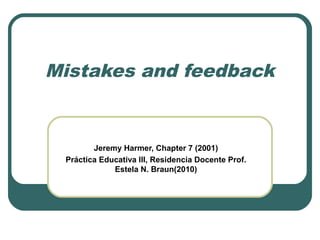
Mistakes and Feedback
- 1. Mistakes and feedback Jeremy Harmer, Chapter 7 (2001) Práctica Educativa III, Residencia Docente Prof. Estela N. Braun(2010)
- 2. Types of Mistakes Julian Edge (1993)divides mistakes into 3 broad categories: SLIPS : students can correct themselves. ERRORS: students cannot correct themselves. ATTEMPTS: ambitious language use, by using structures they have not learnt yet.
- 3. Causes of Errors L1 Interference :sounds, false friends.Eg: parents, embarrased, library. Developmental errors. Overgeneralization. Interlanguage.
- 4. Assessing Students’ performance A. Ignore mistakes/slips B. Encourage risk taking. C.Praise them. D.Avoid over-complimenting them . E. Foster self-assessment. F.Show genuine interest in their work.
- 5. Other information valid as assessment: Comments. Marks and grades. Reports. Self-assessment through checklists . ROA (record of achievement)
- 6. Feedback during Oral Work Difference between ACCURACY (non- communicative activities) FLUENCY (communicative activities)
- 7. When should we provide teacher intervention? Lynch (1997) Use “gentle correction”…”the best answer to the question of when to intervene in learner talk is:as late as possible”. Processing language for communication is the best way of processing language for acquisition. When teachers intervene to correct or to supply alternative modes of expression to help students, they remove the need to negotiate meaning.
- 8. Rapport and feedback Correction builds on the rapport between teacher and students. A good teacher “should be able to correct people without offending them” (Harmer, 1998)
- 9. Feedback during Accuracy Work Two distinct stages: I. Show a student a mistake has been made. II. Help students do something about it.
- 10. Showing Incorrectness 1. Repeating: Again? Use of intonation and expression by the teacher. 2. Echoing: Flight 309 GO to Paris? 3. Satement and question: That’s not quite right. Do people think it’s all right? 4.Expression: facial, gesture, without being cruel or mocking
- 11. And more… 5.Hinting: Say the word: tense, word, plural. Shared metalanguage. 6.Reformulation: If I had heard…
- 12. GETTING IT RIGHT: Ifstudents are unable to correct themselves, focus on the correct version in detail. Foster peer correction in a genuinely cooperative atmosphere. Techniques must not undermine students’self-esteem.
- 13. Feedback during fluency work: We need to respond to content and not just language. Tolerance of erros during fluency sessions should be much greater than during controlled practice sessions. Gentle correction is necessary if communication breaks down or if students need prompting because they do not know what to say.
- 14. Techniques: A)Reformulate what they say: Student: I am not agree with you. Teacher: I don’t agree with you..because.. B) Try not to interrupt the flow of the activity, or we may bring it to a standstill. C) Recording mistakes: Use charts to categorize learners’mistakes: grammar and vocabulary, discourse management, pronunciation, appropriacy,interactive communication.
- 15. Feedback on written work: Workbook exercises. Feedback on creative writing: demonstrate interest in the content of students’work.
- 16. Written Feedback Techniques Responding: We tell them how successful they have been, and which areas they have improved/need to improve.Constructive feedback:learning from errors. Coding: Teachers may use a code with symbols on the margins. We allow students to focus on particular aspects of language:spelling, verb tenses, paragraph construction, cohesion.
- 17. Finishing the feedback process Written feedback is designed as a tool to help learners improve their language use. Importance of rewriting: to see how they respond to our comments. Feedback is part of the learning process. It is over after students have made changes ,consulted grammar books or dictionaries as a way of resolving some of the mistakes we have signalled. (*)See TDI Speaking materials.